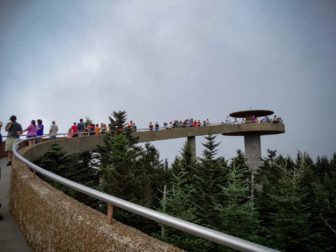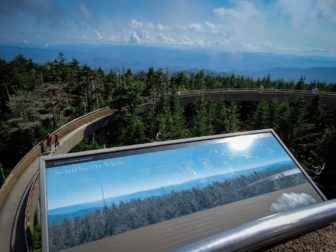CHEROKEE, N.C. – On July 14, the Eastern Band of Cherokee Indians Tribal Council voted to petition the federal government to legally change the name of a well-known hiking destination in the Great Smokey Mountains National Park, known as Clingmans Dome.
The change would revert the name of this area back to Kuwahi (ᎫᏩᎯ in the Cherokee language) meaning “mulberry place,” which the Cherokee people have considered sacred for thousands of years.

Observation tower at Clingmans Dome – Image credit: E. Thornton
The Resolution to change the name of Clingmans Dome back to Kuwahi was submitted by tribal members Mary Crowe and Lavita Hill. Crowe stated that the inspiration to change the name came from a segment of the preamble to the proclamation of Kituwah Mound Day on May 21 of this year, which the Cherokee people purchased their “motherland” of Kituwah (ᎩᏚᏩ in the Cherokee language), reclaiming this sacred land to their sovereign nation.
The specific segment of the preamble Crowe spoke of was when it was said that seven medicine men climbed Clingmans Dome and the great spirit told them, “Your name will be Kituwah forever.”
The name Kituwah is still held by the United Keetoowah Band of Cherokee Indians in Oklahoma and is believed to be the original name of the Cherokee people by this band.
Kuwahi “Mulberry Place”

Southern View from the Observation Tower at Clingmans Dome – Image credit: E. Thornton
At the highest point in the Great Smokey Mountains National Park, on the Tennessee and North Carolina border, at an elevation of 6,643 ft. stands a mountain that is sacred to the Cherokee People.
This mountain not only allowed the Cherokee people refuge, but also those who hid from the forced removal, known as the Trail of Tears, thus creating the Eastern Band of Cherokee Indians. Its significance to the Cherokee spans thousands of years and is inclusive to all Cherokee peoples.
The Legend of Kuwahi has been passed down verbally for centuries but the legend as told by local author to the Smokies Don McGowan, is that medicine men and women would make the arduous climb to the peak to ask for guidance and seek visions from Creator. In turn, they would make the arduous climb back down and share the guidance they received with people in the town of Kituwah, the “motherland,” and surrounding villages.
The Legend also tells of a magic lake, Ataga’hi (Gall Place), that was once seen in the cloud formations below Kuwahi, which could heal and regenerate those who were worthy. On a placard onsite at Clingmans Dome, the words the Great Spirit spoke to the Cherokee are written:
“If they love me, if they love all their brothers and sisters, and if they love the animals of the earth, when they grow old and sick, they can come to a magic lake and be made well again.”
Kuwahi was also believed to be the place of the “Great White Bear” and the meeting place of the bear council, which was located in between Kuwahi and the Oconaluftee river. Wounded Bears were said to have been healed by the regenerative powers of the great lake Ataga’hi.
Clingmans Dome
According to National Park System, Kuwahi became Clingmans Dome in 1859. Thomas Lanier Clingman, a controversial figure in his day, was a state senator from Asheville, NC. He was expelled from office following his support of the confederacy and eventually became a commander, leading the 25th brigade in North Carolina.

Thomas L. Clingman. Provided onsite at Webb Overlook, that faces Clingman’s Dome. E. Thornton
It wasn’t until after the war had ended did he become a surveyor and “scientist” measuring mountains in both North Carolina and Tennessee. With his more accurate measurement of Kuwahi and his promotion of tourism in the area, the peak was named after him.
Due to Clingman’s affiliation with the confederacy and support of slavery and racism in the south, the resolution to change the name of Clingman’s dome mentions that the name was changed to honor an “avowed racist” and was “disrespectful to the Cherokee people, culture, history and tradition.”
In an editorial published by the Cherokee One Feather Editorial Board they state:
“While there still may be some debate among our people on the correct Cherokee language for ‘mulberry place,’ the truth is that the land was named by the Cherokee long before any European came along to rename it. So, essentially, we are not asking for a renaming. Just correct it to the name the Cherokee people gave it in the first place.”
TWH also reached out for a local perspective from an everyday citizen of the Eastern Band of Cherokee Indians, Shay Lambert. Shay stated:
“It’s amazing that I see this view and know my ancestors saw the same view thousands of years ago, and if only by name, we can reclaim it as our own.”
Lambert went on to say how important it is to know the history of Kuwahi and hopes that her generation and future generations will know how important and sacred this place is to the Cherokee people.
As the resolution is the first step in the renaming process and will eventually be determined by the U.S. Board on Geographic names, a petition has been launched on Change.org by Crowe and Hill to gather momentum for the resolution and gather as many signatures as possible.
As other local governments such as the Buncombe County Commissioners have begun to show support for the resolution as well, there just may be hope in returning the original sacred name to such a sacred place for the Cherokee Nation.
The Wild Hunt is not responsible for links to external content.
To join a conversation on this post:
Visit our The Wild Hunt subreddit! Point your favorite browser to https://www.reddit.com/r/The_Wild_Hunt_News/, then click “JOIN”. Make sure to click the bell, too, to be notified of new articles posted to our subreddit.
